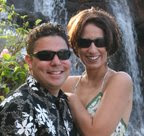Autism (defined here by regional center) is a developmental disorder defined as a syndrome causing significant and sustained impairment in social interaction and communication, with restricted and stereotypic patterns of interests, behavior, and activities which appear before age three. Since Autism is a syndrome, all people who have the disorder will not have all of the different behaviors associated with the disorder. Autism is a lifelong disability.
Children with autism are slow developing self-care, communication, social or learning skills. These skills are often uneven, having good skills in one area and poor skills in another. The person will have limitations in understanding words and ideas, and may be inappropriate responses in sight, hearing, touch, pain or balance. Relationships with people and objects may be abnormal.
Here are a list of behaviors that are Characteristic of Autistic Children: (though a child may not show all of these, showing a significant amount of them could lead to a diagnosis of an Autistic Disorder)
- Difficulty expressing needs; severe language deficits
- difficulty mixing with other children (parallel play)
- Repeats words or phrases in place of normal responsive language
- Acts deaf at times. Tests in normal range of hearing, but not always responsive to verbal cues (doesn't respond to name when called, for example)
- Resists learning
- No fear or danger
- Resists change in routine
- Indicates needs through gesture (may lead adult by the hand, instead of pointing)
- inappropriate laughing
- resists cuddling
- physical over activity
- avoids eye contact
- inappropriate attachment to objects
- spins objects
- sustained odd play
- standoffish manner
- uneven gross/fine motor skills
- laugh, cries, or shows distress for no apparent reason
- unresponsive to normal teaching methods
I took John in for a speech delay, but had also noticed these things:
- would make eye contact for only brief periods of time - nothing sustained
- Abnormal behavior of touch (wanting his hands in my mouth or armpits all the time)
- Difficult time with pointing out objects
- Communication issues (would lead my hand to what he wanted)
- Scattered skills (on a development chart he would have some advanced skills and lack basic skills like stacking blocks)
- Didn't always respond to his name when called
- always in constant movement
Characteristics seen in his evaluation
- tip toe walk
- "W" sit on the floor
- did not respond to his name
- reduced eye contact
- low joint attention (ability to point or look at an object one is directed to)
- Could representational play (imaginary play -- pick up a phone and say hello)
- short attention span
- Difficulty with imitation (this one surprised me because at home,he imitates everything Katie does)
- Could hold crayon appropriately
- Completed peg board quickly in only 25 seconds
- Could retrieve hidden toys quickly
- Easily distracted
- Could follow directions in imaginary play (feed the baby, put the baby to bed)
- needed to be reminded to "watch where he was going"
- words used were not recognizable
- Difficulty in sensory processing
- preference for mother
- engaged in non-functional activity (turning lights on and off repeatedly)
Social Skills : Tested at a 10-17 month level (he was 30 months the day of the test)
Language Skills: tested at a 6-9 month level
Problem Solving: tested at a 21 month level
An "area of concern" is determined when a child tests at 1/3 his age in any category. He was 30 months old when he was tested. Any category where he tested at 20 months or lower was labeled an "area of concern".
The pattern of development shows "at risk" behaviors for an Autistic Disorder. At this time, he has not been "officially" diagnosed with Autism. The pattern meets the criteria for an Autistic Spectrum Disorder. Early Intervention was recommended, as well as a re-test when John is 4 or 5. We are also going to be seeing an Autistic Specialist in October for a second opinion.




No comments:
Post a Comment